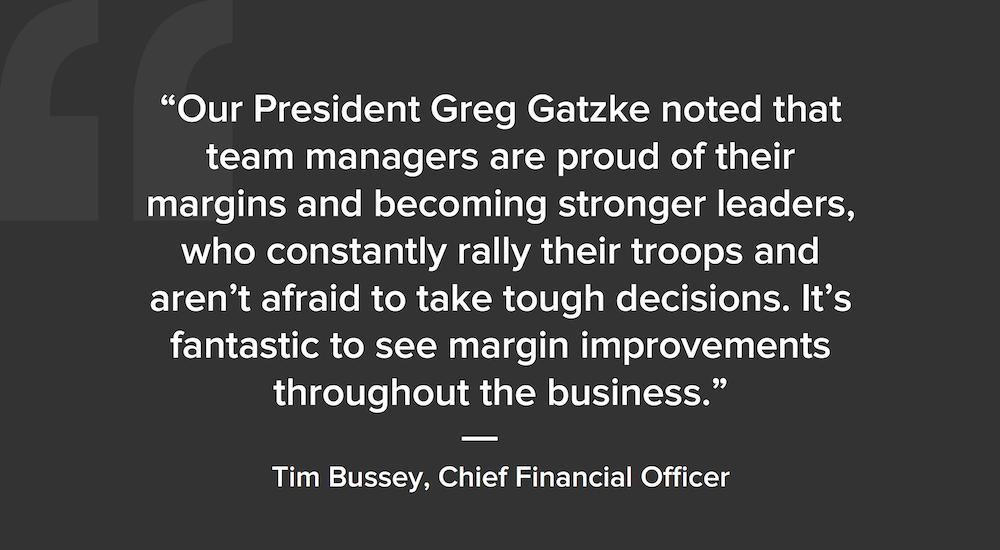“Previously, many decisions were made on gut instinct, where now we have real-time actionable analytics to drive future growth with confidence. Implementing business reporting and intelligence capabilities has been an amazingly powerful transformation.”
— Tim Bussey, Chief Financial Officer
Challenges
Relying on instinct, more than data, to run the business
After 20 years of continuous innovation and improvement on behalf of its clients, ZAG Technical Services began to turn that innovation inward. Through a combination of specialist IT knowledge and steadfast customer support, they helped countless clients become more successful—and grew their team to more than 80 employees.
But for a business that was leveraging digital technology so brilliantly for its clients, ZAG wasn’t always maximizing the opportunity to do the same as it monitored its operational performance.
“While our business had been performing consistently well for two decades, it was being run on instinct rather than driven by detailed data,” explains Chief Financial Officer, Tim Bussey.
“There was a lack of business intelligence and reporting in place to really understand the company, to stop issues in their tracks, or to capitalize on opportunities fast enough.”
To put it simply, in an increasingly digital age, ZAG’s reporting and business analytics capabilities had not kept pace with the times.
With five different lines of business (LOB)—including managed services, project management, and IT security and help desk support—employees were focused on clearing tickets and ensuring clients’ problems were solved. While they collected data on weekly billing, there was no process to analyze employee utilization or different LOB-level revenue and margins.
“Without knowing how much of our employees’ time was being spent on productive billable work, it was impossible to assess their productivity and efficiency, make data-led strategic decisions, or accurately plan for the future,” explains Tim.
This lack of data visibility and analysis became even more unsustainable when ZAG’s founders decided the time was right to chase more explosive growth.
“The CEO saw a huge opportunity to grow the company, and that meant modernizing the use of data,” says Tim. “We needed to start reporting numbers professionally, understand our teams’ utilization and margins, and change our culture to make our people accountable, efficient, and financially focused. In short, empower them with data.”
The race was on to implement better business intelligence. Thanks to one line manager’s energy and initiative, that transformation was already under way. Having come to similar conclusions on the value of data, Application Development Manager Rick Pimentel had already begun building intelligence reports for his team.
“As soon as I joined the business, I realized we needed to transform how we worked,” says Rick. “I decided to leverage some of the tools already available to us, such as Microsoft’s data visualization platform Power BI, to create utilization reports that showed me who in my team was getting the job done most efficiently, who was billing well each week, and who was less productive and required more support.”
When Tim caught wind of Rick’s “ready-to-go analytics,” he felt they dove-tailed perfectly with ZAG’s broader goals.
Using Rick’s technical knowledge, Tim set about implementing similar tools across the business and building a more robust, data-led culture on which ZAG could successfully scale.

Solution
Real-time business intelligence provides clear insights and facilitates tactical decision-making
To implement the new approach to data analytics and business intelligence company-wide, Tim worked with Rick to gather relevant data sources from their issue ticketing and workload software suite. This is the central system used by ZAG to manage client tickets, record workloads, and carry out their billing.
Rick used his engineering experience to source and pull critical data from the ERP into Power BI and other related tooling, including staff utilization numbers and the weekly margins achieved by each line of business.
From a position of next-to-zero analytics, ZAG suddenly had the capability to produce real-time reports that made previously hidden data more visible and digestible. Within Power BI, they could integrate and unify the data to create immersive dashboards that provided more insights and accelerated decision-making.
“Power BI opened the door to amazingly powerful data,” says Tim. “We could visualize each LOB, see who was billing and how much, and see how every person was utilized on a day-to-day basis. We could drill in and see which LOBs were performing best, and which members of the team were the highest performers.”
Armed with such compelling reporting and intelligence capabilities, the next task was to implement this new way of working across the business.
“Our entire business is built on enterprise technology architects and systems designers, so it was a little bumpy asking them to change long-standing habits and become more accountable and efficient,” says Tim. “But everybody knew we were making progress. And they were mature enough to know it was the right thing to do.”
Within weeks, ZAG’s LOB managers embraced the upgraded reporting and business intelligence capabilities, and were generating weekly reports that provided transparency for the CEO. Across the business, managers became increasingly driven and inspired, because instead of relying on instinct and guesswork, they could now:
- Understand who their best performers were — with real-time insights into productivity and billing, line managers could recognize and reward their top employees. They could encourage and nurture the business’ true stars for leadership positions, and help drive future growth.
- React and correct issues quickly whenever utilization fell — because ZAG knew immediately when an employee’s productivity dipped, they could instantly carry out discovery to uncover deeper issues and fix them before they became more significant problems.
- Make the whole workforce accountable for their efficiency and billing — this heightened employees’ capacity, increased dedication to their roles, and transformed ZAG into a data-driven company equipped for rapid growth.
- Understand and compare margins across different LOBs — this enabled ZAG to analyze profitability across different departments and identify trends that might cause future problems to their bottom line.
- Radically improve business planning and forecasting — with reliable and actionable data at their fingertips, ZAG could forecast and plan with confidence and operate their business with full control of their people and processes.
The benefit of ZAG’s increased data visibility went further still. When the global pandemic hit in early 2020, having accurate, professional metrics available made securing a PPP loan a relatively painless experience.
“When the bank asked me to tell them about our business, I had the luxury of all this amazing information to share with them,” says Tim. “Accessing the loan allowed us to navigate through this challenging period with confidence, and ultimately come out the other side stronger.”
Rick, too, recognizes the benefits to his team. “Having real-time data has enabled me to spot cases where employees’ utilization has dropped by as much as 80%. Because we saw that instantly, we could talk to them, get to the bottom of the issue, support them and help resolve the issues, so any impact on productivity and revenue was minimized.”

Results
Upwards of 20% upturn in margin and a data-led culture that inspires increased productivity and performance
ZAG’s transformation into a modern, data-driven business has improved efficiency at every step and enhanced their profitability.
The process of tracking and reporting utilization data has been a catalyst for improving productivity and income. In fact, they’ve seen across-the-board margin improvements, ranging from 5% to a massive 20% in different LOBs.
“With professionally reported accountability part of everyday life, employees accept that it’s a personal representation of their performance,” says Tim.
“Our President Greg Gatzke noted that team managers are proud of their margins and have become stronger leaders, who constantly rally their troops and aren’t afraid to take tough decisions. It’s fantastic to see margin improvements throughout the business.”
With accurate data and insights provided with regularity, Tim can implement the kind of professional-level planning expected of a leading enterprise.
“Where previously, too much was done reactively and instinctively, we now make plans based on actionable insights,” says Tim. “We know what revenue predictions and utilization assumptions to make, and we can even tell LOBs what their revenue targets are, where the growth is going to come from, and what that means for hiring.”
Both Tim and Rick agree that implementing their business intelligence and reporting solution was instrumental in motivating employees and creating a deep cultural shift in the business.
“When employees know their name and performance will be in front of the CEO every week, it motivates and stimulates them,” says Tim. “It’s created a stronger culture of leadership, ownership, and energized our LOB managers.”
For Rick, the results are plain to see. “With our new intelligence capabilities, I can easily track whether team members are getting the job done efficiently and quickly moving on to the next task. We also understand which pieces of our business help us grow and which don’t, which enables us to make smarter financial decisions. Overall, we’re a more efficient business, a more responsive business, and a more dynamic business.”
As a passionate leader committed to solving business problems, Tim is delighted to see business intelligence reporting having such a transformational impact.
“We’ve always been excellent at leveraging IT to deliver competitive advantage for our clients and now we’re doing it for ourselves, too,” he says.

Is your information technology a competitive advantage for your business?
ZAG Technical Services helps you leverage technology to exceed your business objectives. To get the full insights into the challenges, solution, and results delivered by our Business Applications consulting team and Microsoft Power BI, download the case study.



